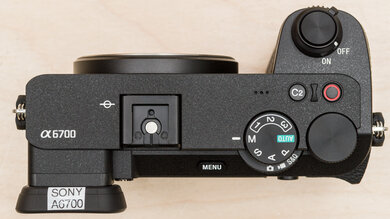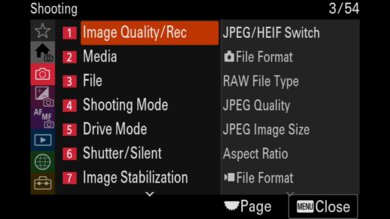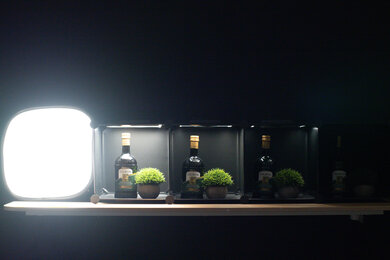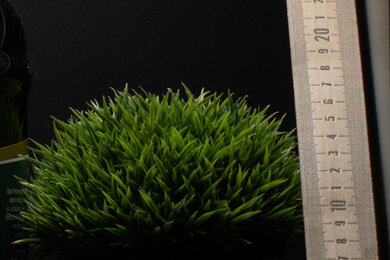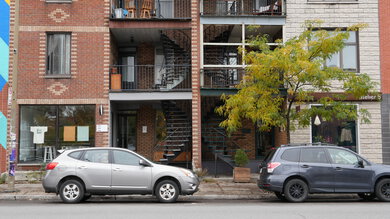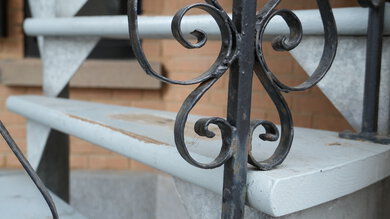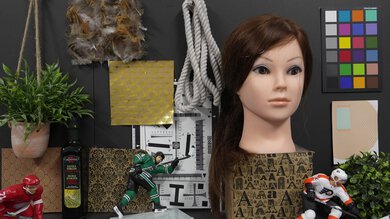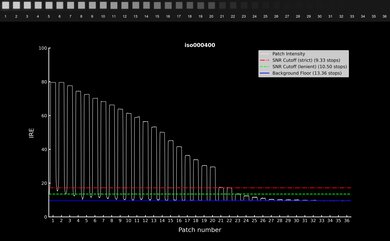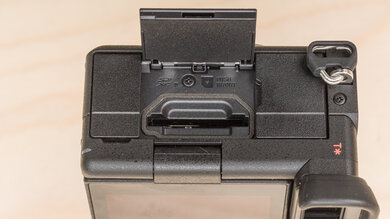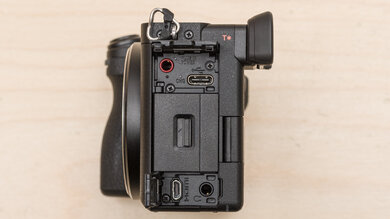The Sony α6700 is Sony's first Alpha camera with an APS-C sensor since 2019's Sony α6100 and Sony α6600. It's a significant upgrade from the previous generation of Sony Alpha APS-C cameras, with a new AI-powered processing unit, upgraded autofocus system, and more advanced video specs. It also comes with some high-end features like in-body image stabilization (IBIS) and weather-sealing, making it one of the most full-featured APS-C cameras on the market in 2023.
Our Verdict
The Sony a6700 is great for travel photography. It's relatively compact and easy to travel with, has good ergonomics, and a long battery life. It's also a very well-built camera, with a weather-sealed body to protect against elements like rain and dust. The image quality out of its APS-C sensor is excellent, and the camera has a great image stabilization system to help you shoot at slower shutter speeds handheld. It has a fantastic autofocus system as well, which tracks moving subjects very well, even in busier settings. That said, its viewfinder isn't the most comfortable to use.
- Relatively portable and lightweight.
- IBIS.
- Fantastic autofocus system.
- Uncomfortable viewfinder.
The Sony a6700 is great for landscape photography. Its APS-C sensor captures excellent image quality overall, and there are plenty of native and third-party lens options available for Sony's E-mount. The camera is also relatively portable, so it won't cause too much fatigue during long days on the go and has a long battery life. It's well-built and weather-sealed, too, with an easy-to-access SD card slot for those who prefer to shoot with a tripod.
- Relatively portable and lightweight.
- IBIS.
- Excellent image quality.
- Uncomfortable viewfinder.
The Sony a6700 is great for sports and wildlife photography. Though it doesn't have the fastest shooting speed on the market, it can still shoot at a quick max burst rate. It also has an amazing autofocus system, with a highly reliable AI-driven subject-tracking feature that lets you track specific subjects like birds or animals and can even recognize different parts of the body. It also captures excellent image quality. That said, its viewfinder isn't especially comfortable to shoot with.
- Relatively portable and lightweight.
- IBIS.
- Fantastic autofocus system.
- Uncomfortable viewfinder.
The Sony a6700 is good for vlogging. It has a fully articulated screen that makes it easy to monitor yourself while vlogging. Its autofocus system does an amazing job of keeping track of faces and ensuring you stay in focus, and the camera is relatively portable for on-the-go vlogging. Plus, it includes AI-powered features like 'Auto Framing', which can help you capture more dynamic footage if you work alone. That said, there's some noticeable rolling shutter effect in 4k, which can be distracting if you do a lot of walk-and-talk vlogging with quick camera movements. It can also overheat during longer recording sessions.
- Fully articulated touchscreen.
- Relatively portable and lightweight.
- IBIS.
- Fantastic autofocus system.
- Can overheat in strenuous shooting conditions.
The Sony a6700 is great for studio video. It has fairly advanced video capabilities, with internal 4k 10-bit 4:2:2 capture and S-Log3 support for those who want to capture a wider dynamic range and have more flexibility in post-processing. You can also power the camera externally via USB-C to extend its battery life. It has both headphone and mic jacks for videography peripherals. Video quality is also excellent for its class, and it records 4k video at up to 120 fps, although with a significant crop. It also has in-body image stabilization to help you get smoother handheld shots. That said, it lacks some more advanced features, like open gate recording and RAW video output, and it can overheat in more strenuous shooting environments or extended recording sessions.
- Relatively portable and lightweight.
- Internal 10-bit 4:2:2 recording.
- IBIS.
- 4k at up to 120 fps (with a crop).
- Can overheat in strenuous shooting conditions.
- No RAW video output.
The Sony a6700 isn't designed for POV-style action video, but it's good for recording action from the sidelines. It's relatively portable, but it isn't designed for action video mounts. On the upside, it has plenty of high frame rate options in both 4k and 1080p, including a dedicated Slow & Quick mode for slow-motion capture in-camera.
- Relatively portable and lightweight.
- IBIS.
- Fantastic autofocus system.
- Can overheat in strenuous shooting conditions.
The Sony a6700 has very good RAW image quality. Its dynamic range is great, capturing a wide range of highlight and shadow detail. It also has a high-resolution sensor, so you have some leeway to crop your photos. However, its noise handling is just decent in low light.
- Great dynamic range.
- Resolves a lot of fine detail.
- Decent noise handling.
Performance Usages
Changelog
-
Updated Dec 12, 2024:
We wrote text for the new tests added in Test Bench 0.13 and updated the Verdict section accordingly.
- Updated Dec 12, 2024: We've converted this review to Test Bench 0.13. We've added new tests for Video Dynamic Range and Luminosity Patch Detection. You can learn more about these updates in the changelog.
- Updated Oct 02, 2024: We added a comparison to the Fujifilm X-T50 in the Portability box.
- Updated Jan 29, 2024: Added text to the 'Raw Photo Performance' verdict box.
Check Price
Differences Between Sizes And Variants
The Sony Alpha 6700 comes in one color variant, Black, and you can see our unit's label here. You can buy the camera body on its own or bundled with a kit lens like the Sony E PZ 16-50mm f/3.5-5.6 OSS lens, Sony E 18-135mm f/3.5-5.6 OSS lens, or other E-mount lenses depending on the retailer.
If you come across another variant, let us know, and we'll update our review.
Popular Camera Comparisons
The Sony α6700 is an amazing mid-range camera with an APS-C sensor. It's one of the most capable APS-C cameras on the market, with advanced video specs, AI-enhanced autofocus, IBIS, and a high-resolution sensor with excellent image quality. Ergonomics are highly subjective, but the more compact, rangefinder-style design of the α6700 may not be to everyone's preference, though it does make for a more portable camera kit compared to more traditional SLR-style alternatives.
If you're interested in exploring other options, check out our buying guides for the best mirrorless cameras, the best cameras for wildlife photography, or the best cameras we've tested overall.
The Sony α6700 is better than the Sony α6400. Beyond its new and improved sensor with a new processor, it's also better built, with a weather-sealed body, and has slightly better ergonomics. While image and video quality aren't far off, the α6700 has significantly better video specs, with internal 10-bit capture and more frame rate options.
The Sony α6700 is better overall than the Sony α7 III, though they use different-sized sensors. The α6700 is a bit more well-rounded, with more advanced video specs, slightly quicker burst shooting, and a newer, more reliable autofocus system. But the α7 III is still an excellent camera, especially if you need full-frame image quality, and it has a larger, more comfortable viewfinder.
The Sony α6700 is better overall than the Sony α6600. It has some notable improvements in design, build quality, and ergonomics. The biggest differences, however, come from its updated video features and new AI-powered processor, which give it improved autofocus subject detection and improve its overall capabilities. That said, image quality is roughly on par.
The Sony α6700 and the Canon EOS R7 are both excellent APS-C powerhouses that can handle a range of photo and video work. The Sony is a bit more tailored towards hybrid shooters, with more video frame rate options and neat features like Auto Framing that make it easier for single camera operators to capture dynamic footage. The Canon, on the other hand, still offers excellent video specs, but it's more explicitly geared towards wildlife and sports photography, with faster burst shooting, a faster max shutter speed, a larger, more comfortable EVF, and dual SD card slots. However, it's notably bulkier than the Sony.
Test Results

The Sony a6700 is quite portable overall, though its larger grip slightly increases its footprint compared to the older generation of Alpha APS-C cameras. Still, it's relatively lightweight and easy to store. If you're after an even more portable crop sensor camera, check out the Fujifilm X-T50.
The Sony a6700 has fantastic build quality. It's a step up from older APS-C models in the Alpha range, with a more grippy texture around the handgrip and a very sturdy-feeling body overall. It's made of a magnesium alloy chassis and hard plastic exterior, which feels premium and well-constructed. The buttons and dials feel strong and offer good physical feedback, and the inputs are covered by secure-feeling doors. The camera's also weather-sealed against dust and moisture. Ultimately, it looks and feels more like the Sony α7C II than predecessors like the Sony α6600.
The body has been slightly redesigned compared to models like the Sony α6600 and Sony α6400. While it has fewer custom buttons, there's also an additional command dial beneath the shutter button, as well as a dedicated 'AF-On' button for back-button focusing. And you still have more than enough controls and buttons to operate the camera efficiently, most of which you can customize to your preference. There's also an additional third custom slot on the mode dial since the Photo/Video/S&Q modes have a new dedicated switch. Separating the mode switch from the PSAM dial also makes it easier to set the shooting mode in video.
The Sony a6700 feels very comfortable to shoot with, though ergonomics are highly subjective. The handgrip is larger than on previous models in the Alpha 6000 series, making it more comfortable to hold, and it includes a few other improvements that make it a lot easier to control. That includes little touches like a grippier texture, along with a more conveniently placed video record button and SD card slot. Overall, it's easy to change settings without having to dive into the menu, with three command dials and a couple of custom buttons that you can set to your preference. Unfortunately, the viewfinder isn't especially comfortable to shoot with. The viewfinder is pretty small, and while the eyecup helps a bit, it isn't as soft as the eyecups on older models.
The EVF has a standard 2.36 million dot resolution. It isn't game-changing, but it provides a crisp view of your subjects when shooting through the viewfinder. That said, the viewfinder is on the smaller side and isn't the most comfortable to use.
Unlike its predecessors, the Sony a6700 has a fully articulated screen, which isn't too surprising, as cameras, in general, are becoming more and more video-oriented. The screen turning mechanism feels solid, and unlike older-gen models, there's full touch capability, so you can use the touchscreen to navigate the menus and settings, as well as select focus points and actuate the shutter.
The menu system is great. It's easy to find what you're looking for, and there are many customization options, including a custom 'My Menu' page where you can add shortcuts to whatever settings you want and a customizable quick 'Fn' menu for commonly used settings. In addition to the 'Fn' menu, you can swipe on the screen to pull up even more settings options. There's also a new 'Main Menu', which acts as a sort of home page, where you can find the most commonly used settings for both photo mode and video mode.
This model is compatible with Sony's Creators' App, which includes the usual functionality you'd expect from a companion app, including transferring files directly from your camera to your smartphone as well as live view and remote operation. On the upside, you can get notifications for new camera firmware updates from the app, which is nice.
The Sony a6700 uses a 26-megapixel backside-illuminated APS-C sensor and Sony's BIONZ XR processor. Like the Sony α7C II, it also has an additional AI-powered processing unit. Sony advertises that the AI chip helps with subject recognition for autofocus, along with making intelligent features like 'Auto Framing' possible.
The a6700 can shoot 10-bit HDR HLG still images in HEIF format. You can see what the colors and image quality of that format (converted to JPEG) look like here, compared to a normal 8-bit JPEG file here. Unfortunately, the camera doesn't support uncompressed RAW files, but you have the option to shoot in either compressed RAW or lossless compressed RAW. You can download a sample compressed RAW file here and a lossless compressed RAW file here.
The camera has excellent overall battery performance. It's CIPA-rated for about 550 photos on a full charge when shooting through the EVF or 570 shots when shooting with the screen. While CIPA ratings don't necessarily align with real-world use, it's a good indicator of how the camera performs relative to others. On that front, the a6700 may not have the highest CIPA rating among its peers, but its battery life is still amazing overall, and you'll get plenty of use out of it on a full charge.
On the video side, it can record for almost two hours of continuous recording in 4k, which is great. If you want to extend the battery life further, you can also use an external power supply via USB-C.
Note that, like other recent Sony cameras, Sony doesn't supply a USB-C cable or charger in the box in an effort to reduce electronic waste.
The camera has a quick max burst rate that's suitable for capturing sequential bursts of fast action. The max burst rate is the same whether you're using the mechanical or electronic shutter, which is great. That said, it isn't the fastest among its peers, with the Canon EOS R7 shooting at a faster 15 fps mechanical and 30 fps electronic. The buffer is also quite small for RAW files. Note, however, that the camera doesn't shoot in uncompressed RAW format—it can only shoot in either compressed RAW or lossless compressed RAW.
The buffer size noted above is for lossless compressed RAW files. If you switch to compressed RAW, you can capture around 103 shots before the buffers fill up. If you do fill up the buffer, the camera empties its buffer very quickly, so you won't be slowed down for long. That's a nice improvement over the Sony α6600, which took an inordinately long time to empty its buffer. If you shoot in JPEG, meanwhile, the buffer is virtually limitless.
The Sony a6700 uses a hybrid autofocus system. Like the Sony α7C II, it has an AI-powered processing unit that's meant to improve its subject-detection algorithms and performance. It not only has face/eye detection for humans but uses what Sony calls "human pose estimation" to recognize other parts of the body and accurately detect where a subject's eyes are, even when they're partially obscured or when the subject turns around. The camera includes several subject detection modes, including 'Human', 'Animal/Bird', 'Insect', 'Car/Train', and 'Airplane'. You can fine-tune the settings, too—for example, in Bird/Animal mode, you can set it to specifically focus on either birds or animals or 'auto' to detect either. You can also choose whether it should prioritize the animal's eye, head, or body. Tracking is available in a number of different area modes, which can help if you want it to prioritize subjects within a specific zone or part of the frame. Ultimately, it's a highly customizable and intuitive AF system.
All in all, it does an excellent job of keeping moving human subjects in focus, with a very high keeper rate when tracking a subject in a busy scene. It's smooth, sticky, and reliable.
If you prefer to use a single center focus point when shooting continuously, the camera seamlessly stays with the subject behind the focus point. There's no hunting or delay, and the focus is very accurate.
The a6700 has in-body image stabilization (IBIS), which helps stabilize the sensor, even when using a lens that doesn't have optical stabilization. The two can also work in tandem to further minimize the impact of camera shake, for instance, when shooting at telephoto focal lengths. We managed to get clear handheld images at very slow shutter speeds using the Sony E 18-135mm F3.5-5.6 OSS lens. That said, stabilization performance can vary depending on many factors, including your lens, focal length, and even the steadiness of your hands.
The Sony a6700 has an impressive amount of usable dynamic range. It can capture a wide array of shadow and highlight detail, which is ideal for high-contrast scenes like landscapes or shots in trickier lighting conditions.
Note: This camera's lossless compressed ARW files aren't compatible with LibRaw and Imatest, the programs we use to measure RAW dynamic range. To get data that's comparable with the other cameras we've tested, as a temporary workaround, we estimated the values above based on the Sony α6600's results. We're working on a fix for this issue, and once we do, we'll update the review.
The camera's high-resolution sensor captures very detailed images, with plenty of leeway to crop in without losing detail.
Note: This camera's lossless compressed ARW files aren't compatible with LibRaw and Imatest, the programs we use to measure RAW sharpness. As a workaround, we converted the ARW file to DNG format using Adobe DNG Converter. We'll retest and update the results, if needed, once LibRaw adds support for the camera's ARW files.
The camera has decent overall noise handling. It performs well enough in low light, though you'll inevitably see some noise when shooting in situations with less available light.
The Sony a6700 captures 4k video, oversampled from the full 6k resolution of its sensor, though, unlike the Fujifilm X-S20, you don't have the option to shoot in 6k. Still, it's a notable step up in video capability from preceding Alpha 6000 models.
The camera can output 10-bit 4:2:2 video to a compatible external recorder via HDMI. It also supports S-Log3 to capture a wider dynamic and tonal range, in addition to HLG and Sony's standard eleven pre-set picture profiles, which include a wide range of gamma curves and color modes. There's also a 'Gamma Display Assist' feature, which lets you preview your Log and HLG videos with a contrast equivalent to a regular gamma curve to simulate how it'll look after processing. You can also import up to 16 custom LUTs (in .cube format), in addition to the camera's built-in 's709' and '709 (800%)' LUTs, and then apply those LUTs to your footage in-camera to speed up your workflow. When shooting in Log mode, you can also toggle the 'Display LUT' setting to preview those LUTs on the monitor.
Like the Sony ZV-E1 and Sony α7C II, the a6700 includes the AI-powered 'Auto Framing' feature, which is useful for single operators. The feature crops into a portion of the frame and automatically tracks your movement, giving the impression of a camera operator moving the camera around to track you. It's meant for use with a tripod, and you can adjust the crop level and tracking speed. If using an external recorder, you can also record an uncropped version of the footage to the recorder as a backup, or vice versa, so you can mix and match wider shots with the cropped auto-framed footage. You can see 'Auto Framing' in action here.
Since the camera now has a USB-C port, you can now use the camera directly as a webcam or for streaming via USB-C, without additional software. It supports streaming in 4k at up to 30 fps with USB-C or 720p at 30 fps if using a USB 2.0 port.
The Sony a6700 records in XAVC format, including XAVC S (MPEG-4 AVC/H.264) and XAVC HS (MPEG-H HEVC/H.265 with Long GOP compression), as well as XAVC S-I for All-Intra recording. XAVC S is available for both FHD and 4k, while XAVC HS is 4k only.
The camera records 4k video at up to 120 fps, which is fantastic despite a significant crop when shooting at 120 fps. It's one of the few cameras we've tested, next to the Fujifilm X-H2S, that can record at that frame rate in 4k. You have plenty of options to capture high-speed footage and slow it down in post. There's also a dedicated Slow & Quick mode that can capture various levels of slow-motion footage in-camera. The S&Q mode doesn't record any audio, though.
The camera has excellent internal recording capability in 4k. As is increasingly becoming standard, it can capture 10-bit 4:2:2 video internally, giving you more leeway to color-grade your footage. There's no recording time limit, either. That said, the camera can overheat with prolonged recording. We experienced a couple of overheat interruptions during our battery runtime test. However, the first interruption only occurred after about an hour of continuous video recording, so you're unlikely to experience that kind of overheating with regular usage. One exception is if you do a lot of livestreaming. We also tested the camera as a webcam, with the 'Auto Power Off Temp' threshold set to 'High', and got a high-temperature warning after about 20 minutes. While the camera never shut down throughout the 50 minutes of streaming, it did get very hot to the touch, with a FLIR gun measuring a temperature of 60ºC on the back panel at the end of the recording.
The camera's autofocus performance is fantastic when shooting 4k video. As in photo mode, you get several different subject detection modes, from regular human/eye detection to animal/bird, insect, and vehicle detection modes. The tracking feature works remarkably well overall, with no trouble keeping up with moving human subjects. Even when manually selecting a target, it reliably stays with the object or subject without any hunting or delay.
The camera's 4k video quality is good overall. It looks great in more controlled lighting conditions, with plenty of sharpness and detail. In low light, it's still decent, but there's some noticeable noise and loss of detail.
The camera has some different stabilization settings in video mode, namely, 'Standard' and 'Active'. 'Standard' simply uses the camera's IBIS and/or OIS to stabilize the footage, while 'Active' adds additional digital stabilization. You can see how each mode performs here.
Enabling the camera's 'Active Stabilization' feature incurs a slight crop, and you can see how the image quality compares with that enabled in 4k at 30 fps here. You can also see a test scene extract taken from a 4k 60 fps clip here and 4k 120 fps here. You can also see a test scene extract from a 4k video recorded in the S&Q mode, with 120 fps recording and 60 fps playback, here. Finally, see here for an extract from a 4k clip using the XAVC HS format.
Note: The lighting in the area in which we perform our low light video quality test has changed, so the 'Low Light Capability' sample video is harder to compare directly with most cameras we tested previously.
The rolling shutter isn't great on the Sony a6700 in 4k. There's some pretty noticeable skewing of vertical lines, which can be distracting when you pan the camera to the side or during vlogs with a lot of movement. That said, it's an improvement over the Sony α6600.
The Sony a6700 can capture FHD video at up to 240 fps, which is fantastic. There's also a dedicated Slow & Quick mode to output slow-motion clips straight from the camera.
Just like 4k, the camera's 1080p internal recording capability is fantastic. It can record 10-bit 4:2:2 footage internally, with no recording time limit. The camera is less likely to overheat in FHD, too.
The camera's AF performs just as seamlessly in 1080p. It's remarkably reliable and accurate, with no difficulty keeping up with moving subjects.
The camera's 1080p video quality is good overall. Videos look especially great in more controlled lighting, but even in low light, the quality is good, without too much noise or loss of detail. You can also see a test scene extract of a video clip recorded in Full HD at 240 fps, slowed down to 120 fps here to compare the camera's video quality in its S&Q mode.
Note: The lighting in the area in which we perform our low light video quality test has changed, so the 'Low Light Capability' sample video is harder to compare directly with most cameras we tested previously.
Rolling shutter is significantly better in 1080p. There's still some distortion with quicker camera movements, but skewing is less pronounced overall.
The camera's video dynamic range is excellent. It captures a very wide range of detail above the background floor when shooting in S-Log3, and even taking noise into account, it has great usable dynamic range. You'll have the widest range above the background floor when shooting at ISO 800, which is the base ISO in S-Log3. The image also cleans up a bit at ISO 2500, giving you a bit more latitude when shooting in low-light situations.
Tested settings:
- Resolution: 4k
- Frame Rate: 30 fps
- Log Format: S-Log3
The camera has a very wide ISO range, giving you a lot of flexibility depending on your shooting conditions. It does a great job of preserving detail both above and below middle gray, with particularly good noise handling in the shadows across most of its ISO range.
Tested settings:
- Resolution: 4k
- Frame Rate: 30 fps
- Log Format: S-Log3
The camera has just a single SD card slot, though it's rated for faster UHS-II cards, which is good. The slot has also been relocated to the side of the camera, rather than being next to the battery, as it is on the Sony α6600. That makes it a little easier to switch out cards, even when using a tripod.
The Sony a6700 uses a USB-C port for charging, file transfer, and power delivery. There's also a Micro HDMI port, along with both a headphone and microphone jack, so you can attach all essential videography peripherals. That said, you'll likely need an adapter for the Micro HDMI to connect an external display.



